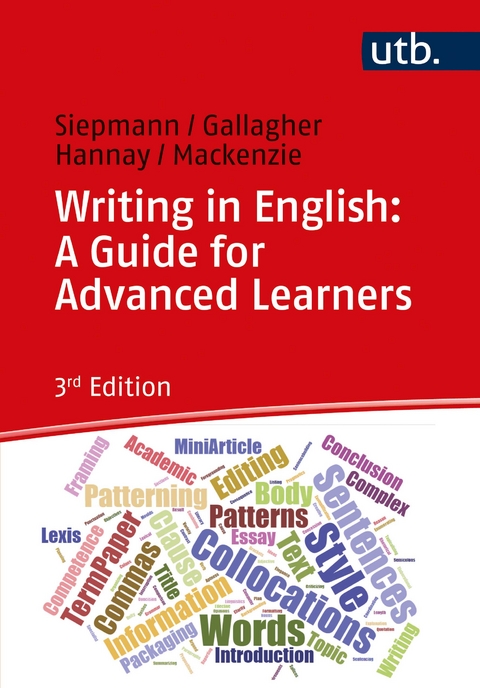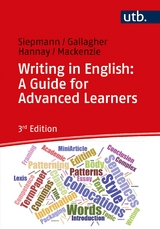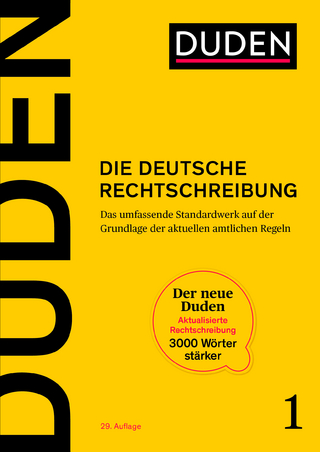Writing in English: A Guide for Advanced Learners
UTB (Verlag)
978-3-8252-5658-6 (ISBN)
Prof. Dr. Dirk Siepmann lehrt Anglistik an der Universität Osnabrück.
John D. Gallager lehrt als Anglist an der Universität Münster.
Prof. Dr. Mike Hannay (em.) lehrte als Anglist an der VU Amsterdam.
Lachlan Mackenzie lehrte Anglistik an der VU Amsterdam.
Prefaces
Introduction
Module I Organizing ideas into text
Introduction
Chapter 1 The term paper: gearing up to start writing
1.1 The term paper as an argued text
1.2 The three processes of planning, writing proper and editing
1.3 Making the plan
1.4 Using a computer
1.5 Conclusion
Chapter 2 Different types of term paper: Two models
2.1 Term paper as essay or as mini-article
2.2 Quotation and paraphrase
2.3 The literary essay
2.4 The linguistic mini-article
2.5 Conclusion
Chapter 3 Title, Introduction, Body and Conclusion
3.1 The Title
3.2 The Introduction
3.3 The Body sections
3.4 Paragraphs within the Body sections
3.5 The Conclusion
Chapter 4 Getting the paper ready for submission: Editing and formatting
4.1 Editing
4.2 Formal requirements
Bibliography
Module II Building effective sentences
Introduction
Chapter 1 Basic issues in sentence construction
1.1 Sentence construction
1.2 Information packaging
1.3 Sentencing
1.4 Overview
Chapter 2 Information packaging
2.1 Basic grammatical moulds
2.2 The order of information in the clause
2.3 Organizing the starting point
2.4 Establishing a special kind of starting point: framing
2.5 Organizing the end point
2.6 What goes wrong in clause construction
2.7 Overview
Chapter 3 Complex sentences
3.1 Different kinds of sentence
3.2 Clause combining: the basic forms
3.3 Foregrounding and backgrounding
3.4 Complex framing
3.5 Interruption techniques
3.6 Elaborational techniques
3.7 Coordinating and listing
3.8 Problems with sentence length
3.9 Review
Chapter 4 Punctuation
4.1 Commas 1: the principle of semantic unity
4.2 Commas 2: optional use
4.3 Colons
4.4 Semicolons
4.5 Dashes and brackets
4.6 Commas revisited: dealing with comma splices
4.7 Overview
Bibliography
References
Module III Lexis and Grammar
Introduction
Chapter 1 A constructional view of language
Chapter 2 Academic lexis and patterning
2.1 Nouns and noun patterns
2.2 Adjective patterns
2.3 Prepositions and prepositional phrases
2.4 Verbs and verb patterns
2.5 The interface between verb patterning and sentence-building
Chapter 3 From word to collocation
3.1 Words, words, words
3.2 How words go together
3.3 Collocation of semantic-pragmatic features
3.4 Collocational gaps and incompatibilities
3.5 Making creative use of collocation
3.6 The interplay of collocation and patterning
Chapter 4 Rhetorical moves and their lexical realizations
4.1 Stating your topics and objectives
4.2 Reporting, summarizing and paraphrasing
4.3 Expressing opinions and criticizing
4.4 Enumerating ideas and changing the topic
4.5 Topicalizing specific items
4.6 Exemplification
4.7 Comparison and contrast
4.8 Concession
4.9 Cause, reason and explanation
4.10 Consequence and result
4.11 Static relations
Bibliography
Module IV Style
Introduction
Chapter I Style and stylistic competence
1.1 What is style?
1.2 How to achieve stylistic competence
1.3 Academic style
1.4 From non-specialist to specialist text
1.5 Personal style
Chapter 2 The principles of style
2.1 Aptness
2.2 Clarity
2.3 Concision
2.4 Variety
2.5 Elegance
Bibliography
Afterword
Glossary
Index
Aus: Exposé - Zeitschrift für wissenschaftliches Schreiben und Publizieren - Simone Christina Jerke - Exposé 1-2023
[...] Ganz im Gegenteil legen die Autoren Wert darauf, den Lesenden das notwendige grammatikalische Rüstzeug mitzugeben, um durch Fleiß und Training ein belastbares und profundes Verständnis von Textaufbau und -wirkung zu entwickeln. Wer sich die Zeit nimmt, den laden die Autoren dazu ein, sich im Fachbuch zu vergraben, zu schmökern und abzutauchen in die spannende Welt englischsprachlicher Schreibfertigkeit [...]
Aus: media-mania.de, Markus Goedecke, 30.10.2009
[...] Writing in English: A Guide for Advanced Learners" ist ein hochinteressanter und sehr aufschlussreicher Leitfaden zur Verbesserung der eigenen Fähigkeiten im Schreiben von englischen Texten. Zielpublikum ist an erster Stelle ganz klar der akademische Zweig. So eignet sich das Buch sehr gut zur Verwendung in Schreibseminaren, aber auch als umfangreicheres Referenzwerk im Bücherregal von Studenten. Auch für Englischlehrer in der Oberstufe des Gymnasiums sowie für Menschen in der freien Wirtschaft, die viel mit englischen Texten zu tun haben, bietet "Writing in English" einige interessante Aspekte. Der Preis von 22,90 Euro ist im Vergleich mit anderen wissenschaftlichen Veröffentlichungen eher moderat und somit durchaus vertretbar. [..]
» Zum Volltext der Rezension
| Erscheinungsdatum | 21.02.2022 |
|---|---|
| Verlagsort | Stuttgart |
| Sprache | englisch |
| Maße | 150 x 215 mm |
| Gewicht | 779 g |
| Themenwelt | Schulbuch / Wörterbuch ► Wörterbuch / Fremdsprachen |
| Geisteswissenschaften ► Sprach- / Literaturwissenschaft ► Sprachwissenschaft | |
| Schlagworte | academic text conventions • Argumentation • Deutsch • Englisch • English • Essay • idiomatic phrasing • Schreiblehrbuch • sentence construction • Style • text organisation • Writing in English |
| ISBN-10 | 3-8252-5658-8 / 3825256588 |
| ISBN-13 | 978-3-8252-5658-6 / 9783825256586 |
| Zustand | Neuware |
| Informationen gemäß Produktsicherheitsverordnung (GPSR) | |
| Haben Sie eine Frage zum Produkt? |
aus dem Bereich




